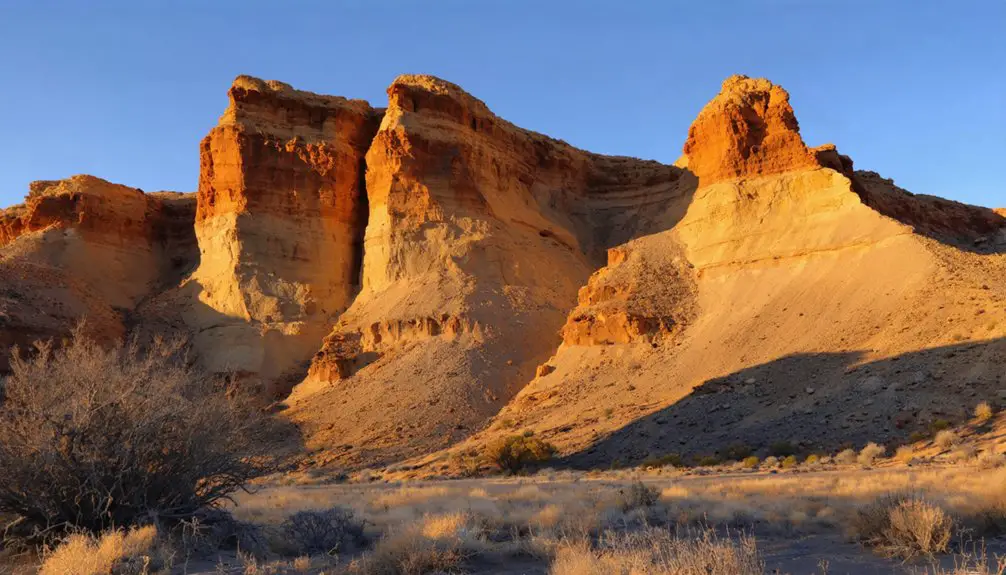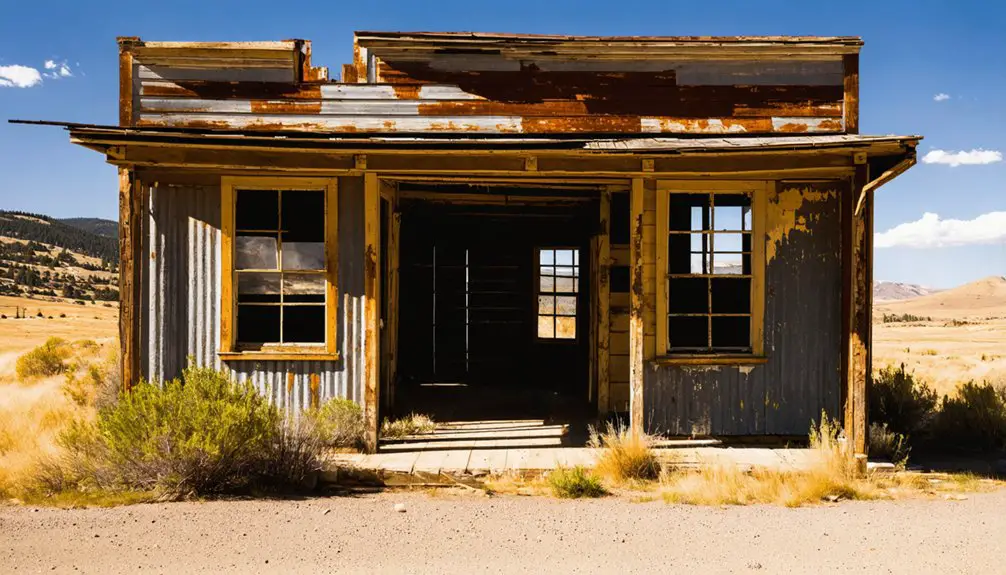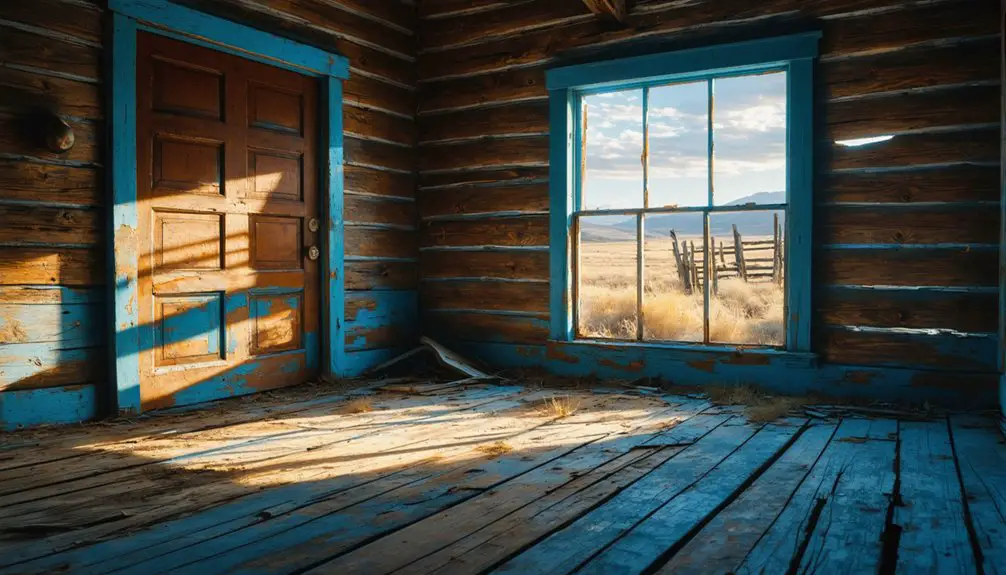You’ll discover a geological wonderland of towering cliffs and honeycomb formations in Leslie Gulch, a remote 11,673-acre sanctuary tucked away in Oregon’s southeastern corner. This untamed landscape features volcanic ash deposits shaped over 15.5 million years into stunning yellow, red, and brown hues. You’ll spot California bighorn sheep roaming the rugged terrain and rare plant species thriving among the rocks. This remarkable destination holds countless natural treasures waiting to be explored.
Key Takeaways
- Leslie Gulch features dramatic volcanic cliffs and honeycomb formations shaped by wind and rain over 15.5 million years.
- The area hosts North America’s largest California bighorn sheep herd and five rare plant species in its pristine wilderness.
- Best visited during spring (April-May) for wildflowers or fall (September-October) for mild temperatures and fewer visitors.
- Access requires a 15-mile gravel road drive from Jordan Valley; high-clearance vehicles recommended for the rugged terrain.
- Pack essential supplies including water, emergency gear, and sturdy hiking boots, as the area lacks developed facilities.
A Hidden Gem in Oregon’s Outback
Tucked away in Oregon’s remote southeastern corner, Leslie Gulch stands as one of the state’s most spectacular yet lesser-known natural wonders.
You’ll discover towering cliffs and honeycomb-like formations carved from ancient volcanic ash, creating a dramatic landscape that feels worlds away from civilization.
As one of Oregon’s hidden treasures, this 11,673-acre preserve invites you to explore its rugged terrain where the state’s largest herd of California bighorn sheep roams freely. The herd, which now exceeds 200 animals, was first established in 1965.
Your outdoor adventures here unfold against a backdrop of golden rhyolite spires and sage-covered plains, all leading down to the serene waters of Owyhee Lake. The area’s rich history includes thousands of years of human exploration and settlement.
While the gravel roads might challenge your vehicle, they’re your gateway to an unspoiled wilderness that showcases the raw beauty of Oregon’s outback heritage.
Getting There: Your Journey to Leslie Gulch
While reaching Leslie Gulch requires careful navigation through Oregon’s remote southeastern corner, the journey itself becomes part of the adventure.
From Jordan Valley, you’ll head north on US-95 before winding your way through a series of turns that lead to Leslie Gulch Road, where scenic views begin to unfold.
The final 15-mile stretch offers a thrilling drive on gravel, though you’ll want a high-clearance vehicle for the best experience.
The rugged gravel path demands respect, beckoning adventurous souls with high-clearance vehicles to discover its untamed beauty.
Look for the Owyhee River as you approach the area, offering breathtaking views along your route.
Here are essential travel tips: fuel up before leaving Jordan Valley, pack plenty of water and supplies, and check road conditions, especially after storms.
While 4WD isn’t always necessary during dry weather, it’s recommended for peace of mind.
Upon arrival, you’ll find yourself at Leslie Gulch Camp, conveniently located just 0.1 miles from the main area.
Natural Wonders and Geological Marvels
You’ll stand in awe beneath Leslie Gulch’s towering cliffs and spires, where volcanic ash flows from 15.5 million years ago created a maze of honeycomb-patterned rock formations.
The dramatic walls showcase nature’s artistry through their distinctive yellows, reds, and browns, all carved by centuries of wind and rain into fantastic shapes resembling Swiss cheese. The ancient caldera that formed this region spans an impressive 15 by 20 kilometers.
These ancient volcanic deposits tell a compelling story of explosive eruptions and geological forces that shaped this desert wonderland into the remarkable landscape you see today. The area’s unique terrain is enhanced by hardy western juniper trees, which have thrived in this high desert environment for centuries.
Towering Honeycomb Rock Formations
Monumental towers of volcanic rock pierce the skyline at Leslie Gulch, where nature’s patient hand has carved intricate honeycomb patterns into the cliffs.
You’ll discover an otherworldly landscape sculpted from ancient volcanic ash that fell 15.5 million years ago, now transformed into stunning rhyolite tuff formations reaching heights of 1,000 feet. The area has been designated as an Area of Critical Concern due to its exceptional geological and ecological significance. The remote canyon provides crucial habitat for the largest bighorn sheep population in the United States.
Trek along hiking trails that wind through this geological wonderland, where you’ll find:
- Terra cotta-colored spires rising dramatically from the canyon floor
- Weathered rock faces dotted with mesmerizing honeycomb patterns
- Hidden caves and rock shelters perfect for photography spots
- Rare desert wildflowers thriving in the volcanic soils
These majestic formations tell a story of explosive volcanic power and time’s endless sculpting, creating one of Oregon’s most remarkable landscapes.
Ancient Volcanic Desert Landscape
Deep beneath your feet lies a dramatic story of volcanic fury that shaped Leslie Gulch 15.5 million years ago, when massive eruptions released an inferno of ash and molten rock across the landscape.
You’re standing in what was once a massive caldera, where explosive forces ejected over 280 cubic kilometers of rhyolite debris, creating the foundation for today’s otherworldly terrain.
As you explore these volcanic formations, you’ll witness nature’s patient artistry – where wind and water have carved through layers of ancient ash deposits, revealing a geological history in vivid yellows, reds, and browns. Today, these colorful canyon walls create a striking backdrop for outdoor adventurers and photographers alike.
The Leslie Gulch Tuff forms the majority of these remarkable volcanic structures that dominate the landscape.
Underground basalt dikes have emerged as bold columns, while the softer volcanic tuff has eroded into honeycomb patterns and towering spires, offering you a glimpse into Oregon’s fiery past.
Wildlife and Rare Plant Species
Leslie Gulch’s wilderness teems with remarkable wildlife and rare botanical treasures found nowhere else on Earth.
You’ll discover incredible wildlife diversity as you explore, from majestic California bighorn sheep scaling steep cliffs to golden eagles soaring overhead. The canyon’s volcanic soils nurture five extraordinarily rare plants, including two species that exist only within this drainage.
For the adventurous spirit, here’s what you can’t miss:
- Watch for the 200+ bighorn sheep that roam the canyon walls
- Spot raptors nesting in towering cliff faces
- Search for the endemic Packard’s blazing star in ash deposits
- Listen for coyotes echoing through the gulch at dusk
Plant conservation efforts protect these unique species while limiting human impact, preserving this untamed sanctuary for future explorers.
Essential Tips for Your Visit
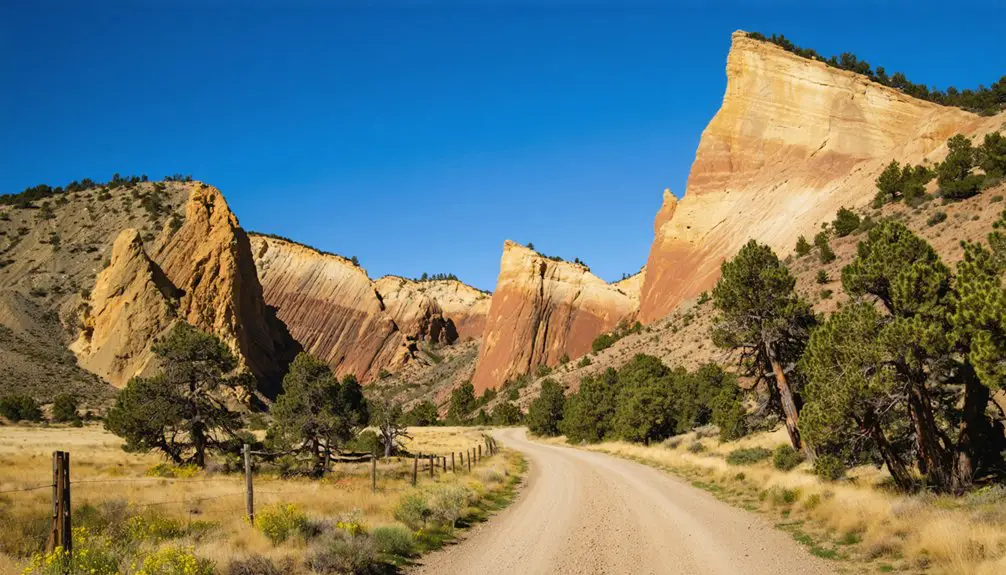
You’ll need to pack strategically for Leslie Gulch’s remote desert environment, bringing plenty of water, layered clothing, and emergency supplies since there’s limited cell service and no developed facilities.
Spring offers your best chance to explore comfortably with temperatures in the 60s to 80s Fahrenheit, though weather can shift dramatically from warm sunshine to snow within days.
Watch the unpaved roads carefully, especially after rain, and consider bringing a high-clearance vehicle to navigate the rough, washboarded terrain that demands speeds of 10-15 mph.
Pack Smart Stay Safe
While the rugged beauty of Leslie Gulch beckons adventurers year-round, proper preparation is essential for a safe and enjoyable visit to this remote desert wonderland.
You’ll need smart hydration strategies and food packing plans to tackle this untamed landscape where services are nonexistent and conditions can change rapidly.
Your survival and comfort in Leslie Gulch depend on these vital preparations:
- Pack a minimum of 1 gallon of water per person daily, plus a reliable filtration system
- Load up on high-energy, non-perishable foods and extra emergency supplies
- Wear moisture-wicking layers and sturdy hiking boots for challenging terrain
- Carry the Ten Essentials, including navigation tools and emergency gear
Best Time To Visit
The mesmerizing beauty of Oregon’s high desert comes alive during late spring and early fall, when Leslie Gulch’s dramatic landscape offers its most welcoming conditions.
You’ll discover vibrant spring blooms carpeting the rugged terrain in April and May, while temperatures remain moderate enough for comfortable exploration.
If you’re seeking fall solitude, plan your adventure between September and October. You’ll encounter fewer fellow travelers and enjoy crisp, clear days perfect for photography and hiking.
Summer visits, while feasible, require careful timing to avoid intense heat – stick to early morning or late afternoon explorations.
Skip winter altogether, as snow, ice, and potential flash floods make conditions treacherous.
Remember to check road conditions before your trip, as weather can quickly transform the gulch’s unpaved access routes.
Weather And Road Conditions
Understanding Leslie Gulch’s distinct weather patterns becomes essential once you’ve planned your visit dates.
You’ll experience hot summers reaching 96°F and winter temperatures near freezing, so timing your adventure is vital. The area’s gravel roads demand high-clearance vehicles, especially after rain when conditions can become challenging.
Here’s what you need to know about Leslie Gulch’s conditions:
- Summer brings clear skies and dry roads, but expect dust on unpaved routes.
- Winter sees occasional ice and near-freezing temperatures that might restrict access.
- Spring can present muddy roads and variable weather, requiring flexible plans.
- Fall offers moderate temperatures but prepare for significant day-to-night swings.
Pack plenty of water, check road conditions before heading out, and bring appropriate gear for weather changes – you’re entering wild country where preparation equals freedom.
Best Times to Experience Leslie Gulch
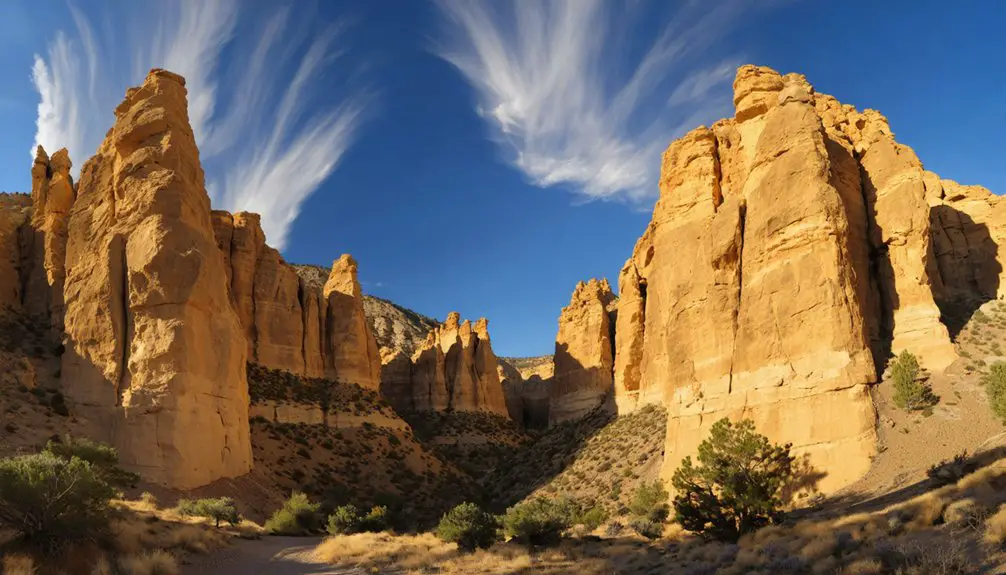
Planning your visit to Leslie Gulch demands careful timing to experience its majestic beauty in ideal conditions.
Timing is everything when exploring Leslie Gulch’s dramatic landscapes – plan strategically to witness its raw beauty at its finest.
You’ll find the most rewarding spring adventures during April and May, when mild temperatures and blooming wildflowers create perfect hiking conditions. Early fall offers another prime window, with comfortable temperatures ideal for fall photography and exploration.
Avoid summer’s intense heat unless you’re solely focused on accessing dry roads and don’t mind scorching temperatures. Winter visits aren’t recommended due to treacherous ice and snow conditions.
For the best experience, target those sweet spots in spring and fall when you can comfortably trek through Juniper Gulch, capture stunning photos, and spot wildlife without battling extreme weather.
Just remember to check weather forecasts and road conditions before heading out – nature calls the shots in this rugged paradise.
Frequently Asked Questions
Are There Any Cell Phone Signals or Emergency Services in Leslie Gulch?
You won’t find any cell service in Leslie Gulch, and there’s no immediate emergency services. You’ll need satellite communication devices for emergency contact. Plan ahead and be self-reliant in this remote wonderland.
Can I Bring My Dog to Explore Leslie Gulch Trails?
You’ll dig these dog friendly trails like your pooch digs ancient bones! Bring plenty of water and watch for rattlesnakes. Keep your companion leashed and protected from hot surfaces for pet safety.
Is Overnight Camping Allowed Outside the Designated Campground Areas?
No, you can’t camp outside Slocum Creek Campground – wild camping regulations strictly prohibit it. To protect Leslie Gulch’s fragile ecosystem and follow backcountry etiquette, you’ll need to stick to designated sites.
Are Drones Permitted for Photography in Leslie Gulch?
You’ll need special permission for drone photography in Leslie Gulch due to strict BLM regulations. It’s an environmentally sensitive area where drone use is typically restricted to protect wildlife and preserve natural serenity.
Where Is the Nearest Gas Station to Leslie Gulch?
Don’t let your tank run dry in no-man’s land! You’ll find your nearest gas station in Marsing, Idaho, where you’d better fuel up before heading south – it’s your last reliable pit stop.
References
- https://en.wikipedia.org/wiki/Leslie_Gulch
- https://www.lorjorexplore.com/blog/timber-gulch-oregon
- https://www.wanderinraw.com/post/leslie-gulch
- https://alifeofadventures.com/blog/guide-to-visiting-leslie-gulch-and-the-owyhee-canyonlands/
- https://www.npsoregon.org/kalmiopsis/kalmiopsis11/lesliegulch.pdf
- https://topoquest.com/place-detail.php?id=1123049
- https://www.topozone.com/oregon/malheur-or/valley/leslie-gulch/
- https://www.topozone.com/oregon/malheur-or/locale/leslie-gulch-boat-ramp/
- https://travelingbrowns.weebly.com/2014-24-leslie-gulch-high-desert-of-eastern-oregon.html
- https://wickershamsconscience.wordpress.com/2017/06/20/geology-101-leslie-gulch/
